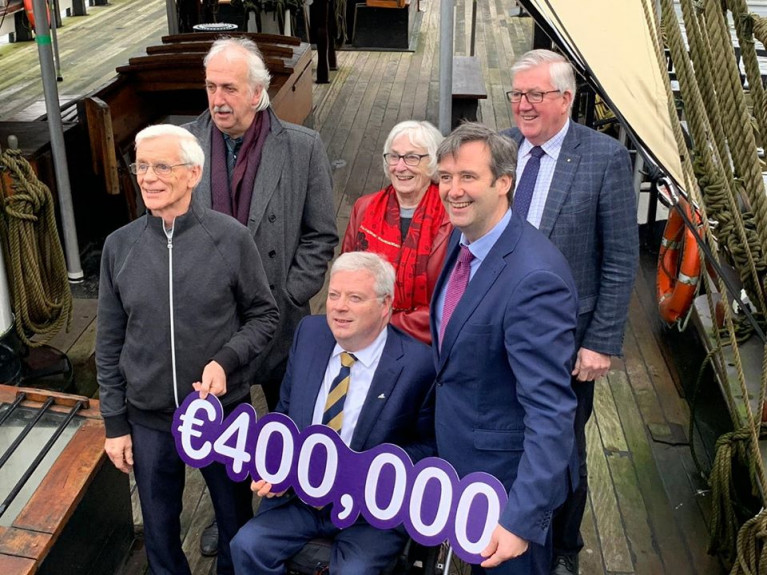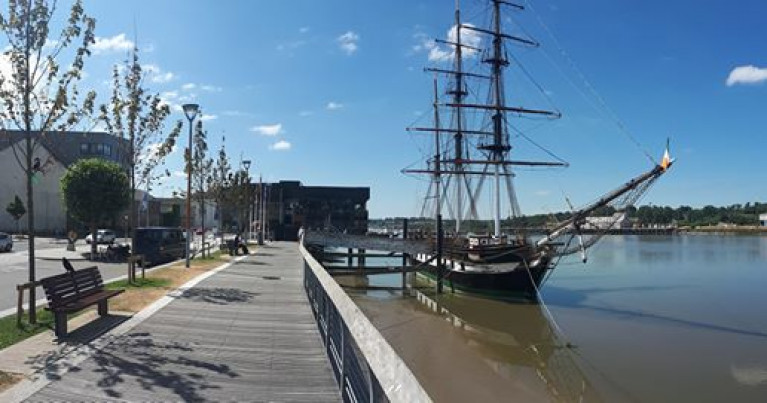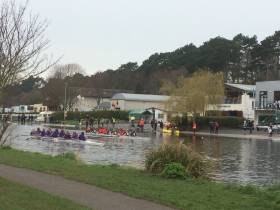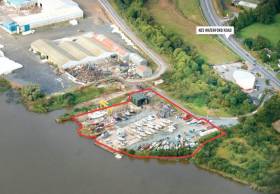Displaying items by tag: New Ross
The Three Sisters Cruise Company Limited officially launched the Barrow Princess River Cruise Experience at New Ross marina last month.
Dignitaries from across the Southeast were welcomed to New Ross Marina for the official launch of the Barrow Princess.
Master of ceremonies, Tony Ennis welcomed guests and thanked all who contributed to bringing this new service to fruition.
Tony, of Ennis & Co Business Consultants, himself involved in the project since inception, spoke of the significant investment that this unique innovative undertaking required, not just financially by Declan, but in cooperation and collaboration across county boundaries of all the parties involved. To represent this joint collaboration, Deputy Mayor of Waterford City and County Council, Cllr Seanie Power and deputising for New Ross Municipal District Chair, Cllr Michael Sheehan, cut the ribbon together with Declan officially launching the new venture.
 The Barrow Princess River Cruise Experience berthed at New Ross marina
The Barrow Princess River Cruise Experience berthed at New Ross marina
Eamonn Hore, Wexford County Council Director of Service, expressed his delight with the arrival of the Barrow Princess to the marina in New Ross stating that “The river cruises offered by this beautiful boat are a fantastic addition to the many charms and attractions of New Ross and the majestic River Barrow. I would like to wish Declan and his team every success with this wonderful venture”.
Speaking at the event, owner Declan Bates said “We are delighted to be here today. We have been working on this project since 2013 and it is a very proud moment for us to officially launch the Barrow Princess River Cruise experience today. We could not have done it without the support of Wexford Local Development/LCDC, Wexford County Council, Waterford City & County Council, the Port of Waterford Authority, Failte Ireland, Ennis & Co consultants, Prolines Naval Architects & Marine Surveyors, and Arklow Marine Services and those who got onboard with the idea from the very start and saw the potential, Sean Reidy and Eamonn Hore in particular, and of course the many other suppliers, family and friends and our hard-working crew who have supported us along the way. We are happy with the service offering we now have in place, the reviews we have received to date have far exceeded our expectations. We are delighted that the cruises have been so well received by the public and look forward to welcoming locals and visitors alike aboard.”
Following the official ceremony, guests enjoyed refreshments and a majestic mini cruise along the Barrow River to the Rose Fitzgerald Kennedy Bridge.
Wexford's Tallship Dunbrody Ship-Shape With €400,000 Funding
Funding of around €400,000 from the Government has been allocated towards maintenance works on the Dunbrody Famine Ship over recent years.
The funding, according to the New Ross Standard, has been used to carry out essential works to the tallship (barque) vessel, including painting, waterproofing and the instalment of a lift.
Minister of State Michael D'Arcy Jnr said: 'The ship has a high level of maintenance work which has to be done. At a particular point we gave a commitment of €400,000 in funding.'
The barque went into dry dock at New Ross Boat Yard in January 2017 for several weeks and substantial repair and improvement works were carried out. She will once again go into dry dock in early 2021 for further works. Mr D'Arcy said the ship has been greatly improved over the past two years. A survey of the rigging will take place in early February, with specialists arriving from Cork at New Ross Boat Yard to carry out the job.
Mr D'Arcy was highly complimentary of the work of Dunbrody staff. 'This is one of the major tourism projects, not just in Wexford, but in Leinster and Ireland. My view on this is that the tourist projects like this need to cluster with other projects like Hook Lighthouse and the Irish National Heritage Park. There are very few projects in any other county that are as close to each other.'
The newspaper has more here on the story.
New Ross Chamber's 2020 Vision for the Future
At the top of the agenda at New Ross Chamber is to attract a major company, writes Independent.ie
The executive group met in New Ross on Tuesday and during a lengthy meeting four priorities were outlined. Chamber President Sean Reidy said these include attracting a major company to the town within four years, local stakeholders taking back ownership of the port, getting a large new hotel for the town and attracting a major retailer to open a shop in the town centre.
Mr Reidy said stevedores at New Ross Port are seeking to have more of a say in its running, after it was announced earlier this year that Waterford Port was being lined up to take control of its operations. 'The future development of the port is a big priority as the port has a big say in New Ross and in the stakeholders in New Ross. There is the issue of it going to Waterford but we have views on that and we have stakeholders on our board who are currently in discussions with the county manager about running the port. I would hope a way could be found. On the one hand it can't be in the hands of private enterprise. We would be really emphasising our fear that will Waterford promote New Ross in the way we want it promoted. We feel New Ross stakeholders need to have a say in how it is run going forward and we are supporting the stakeholders in the town in those discussions.
#Rowing: The first set of finals at Neptune Regatta was a good one for UCD. Their B crew beat Neptune – by three-quarters of a length – in the competitive club one eights and their B crew beat Trinity in the novice eights. However, Trinity won the battle of the senior coxed fours – their B crew beat UCD. The host club provided be the top junior 18 eight, beating Coláiste Iognáid in the final.
The women’s junior 18 eight gave Graiguenamanagh a win over Coláiste Iognáid by a canvas, while the club one eights went to Commercial, who beat UCD B. In the closest race of the session, Katie Dolan of Commercial beat Niamh Clarke of Neptune by just one foot in the women’s junior 18 single sculls. Luke Sutton of New Ross won the men’s junior 18 single.
Neptune Regatta, Islandbridge, Saturday (Selected Results)
Men
Eight – Club One: UCD B bt Neptune ¾ l, 3:20. Novice: UCD B bt Trinity 3l, 3:30. Junior 18: Neptune bt Col Iognaid 2l, 3:27. Jun 15: Bann bt St Joseph’s 1 ½ l.
Four – Senior, coxed: Trinity B bt UCD 2l, 3:35. Masters, coxed: Athlone bt Neptune ¾ l.
Sculling, Quadruple – Jun 16, coxed: Fermoy bt Bann 3:50.
Double – Jun 16: Col na Coiribe bt Commercial A 3l, 4:01.
Single – Club Two: Clonmel (S O’Donnell) bt Garda (P Ryan) 4l, 4:25. Jun 18: New Ross (L Sutton) bt Commercial (C Kelly) easily, 4:00.
Women
Eight – Club One: Commercial bt UCD B 2l, 3:50. Jun 18: Graiguenamanagh bt Col Iognaid, canvas 3:53. Novice: UCD A bt UCD B 4l, 4:00. Jun 15: Galway bt Enniskillen 4l.
Sculling, Quadruple – Jun 16, coxed: Commercial bt Carlow 2 ½, 4:12. Double – Jun 16: Fermoy A bt Commercial B, easily, 4:34.
Single – Club Two: Clonmel (S McGrath) bt Clonmel (E Fitzpatrick) 4l. Jun 18: Commercial (K Dolan) bt Neptune (N Clarke) 1ft, 4:30.
Busy New Ross Boat Yard Comes To Market
#Property - New Ross Boat Yard in Co Wexford is now on the market at a price point of €4 million.
With 230 metres of frontage on the River Barrow and easy access to the Nore and Suir (and by extension the South East Coast), the 1.62-hectare property also comes with a sizeable dry dock, one of only three in the Republic that can handle large commercial boats.
Additionally on the site is a 50-tonne marine travel lift and winter storage space or as many as 150 vessels, thanks to signifiant refurbishment over the last decade by its present owner.
With an annual turnover of €840,000, and planning permission in place to adapt the dry dock for year-round service, the boat yard is sure to be an attractive prospect.
Five People Found In Shipping Container In Wexford
#Shipping - Five people were found in a shipping container in Wexford at the weekend, as BreakingNews.ie reports.
The three men, a woman and a young girl, all believed to be Kurdish, were discovered at a haulage yard in New Ross on Sunday evening (16 October) in a container thought to have come in on a ferry from Cherbourg to Rosslare Europort.
Gardaí said the five, who were in good health, are being detained under immigration law — and are claiming asylum due to persecution in their home region.
According to TheJournal.ie, New Ross is also where nine Kurdish refugees were found in the back of a truck after stowing away on a ferry from France to Rosslare this past February.
#JFKennedy50th- The Eternal Flame taken from the grave of former US President John F. Kennedy in Washington has arrived to Dublin Airport this morning and is to be transferred to the Naval Service in Dublin Port and carried by sea to New Ross, writes Jehan Ashmore.
This is the first time that the flame has been given permission to be taken from the Kennedy grave at Arlington National Cemetery, since the assassination of President Kennedy in June 1963.
A ceremony will be held later today when the flame is passed over from the Defence Forces to the Naval Service CPV coastal patrol vessel L.E. Orla (P41) which is berthed along Sir John Rogerson's Quay.
L.E. Orla is scheduled to depart Dublin Port mid-afternoon with the flame on board the CPV and taken to New Ross where the Wexford town is marking his 50th anniversary visit.
On Saturday, John F. Kennedy's daughters Caroline Kennedy and Jean Kennedy Smith will be guests of honour along the Quayside in New Ross accompanied by An Taoiseach Enda Kenny and where they are to use the Eternal Flame to light the Emigrant Memorial beside the replica Dunbrody famine tallship.
The flame will also be brought to the Kennedy Monument in his ancestral homeland as a final act to mark the half-century anniversary.
Three Sisters Marina at New Ross in County Wexford is on the River Barrow and it is New Ross Town Council facility. It is nine miles up river from the confluence of the Suir and Barrow and it is 18 nautical miles from the sea at Hook Head.
The marina is a modern 66 berth facility. The marina has electrical shore power, mains water toilets and shower facilities. Alongside the marina is a major lift-out facility catering for vessels up to 50 tonnes.
The Marina Manager: John Dimond. The Email: [email protected]
Phone: 086 3889652 or 051 421284
Shore Angling Competition Raises Funds for Courtown Lifeboat
#ANGLING - Strongs winds and heavy seas weren't enough to dampen the spirits of the anglers taking part in the Courtown Sea Anglers RNLI fundraising event last Sunday, the Gorey Guardian reports.
Top winner on the day in the shore angling competition at Kilgorman beach was James Ryan from New Ross, who hooked an impressive 24 fish - all of which went back in the water under catch-and-release rules.
Anglers from Galway, Belfast, Clare, Wicklow, Dublin, Waterford and across Wexford took part. It is hoped that more than €4,200 was raised to support the Courtown lifeboat.
New Centre at Dunbrody Tells the Irish-American Story
Tomorrow sees the official opening ceremony of Ireland's first visitor centre dedicated to the history of emigration.
The National Centre for Emigration History in New Ross, Co Wexford, which incorporates the Irish America Hall of Fame, will be opened by Minister for Transport, Tourism and Sport Leo Varadar, joined by famous Irish-American Michael Flatley.
Located on the quay side of the River Barrow next to the popular tall ship Dunbrody, which commemorates the Great Famine, the €2.6 million interative centre features a state-of-the-art exhibition on the story of Irish emigration, plus a genealogical resource for visitors hoping to trace their Irish heritage.





































































